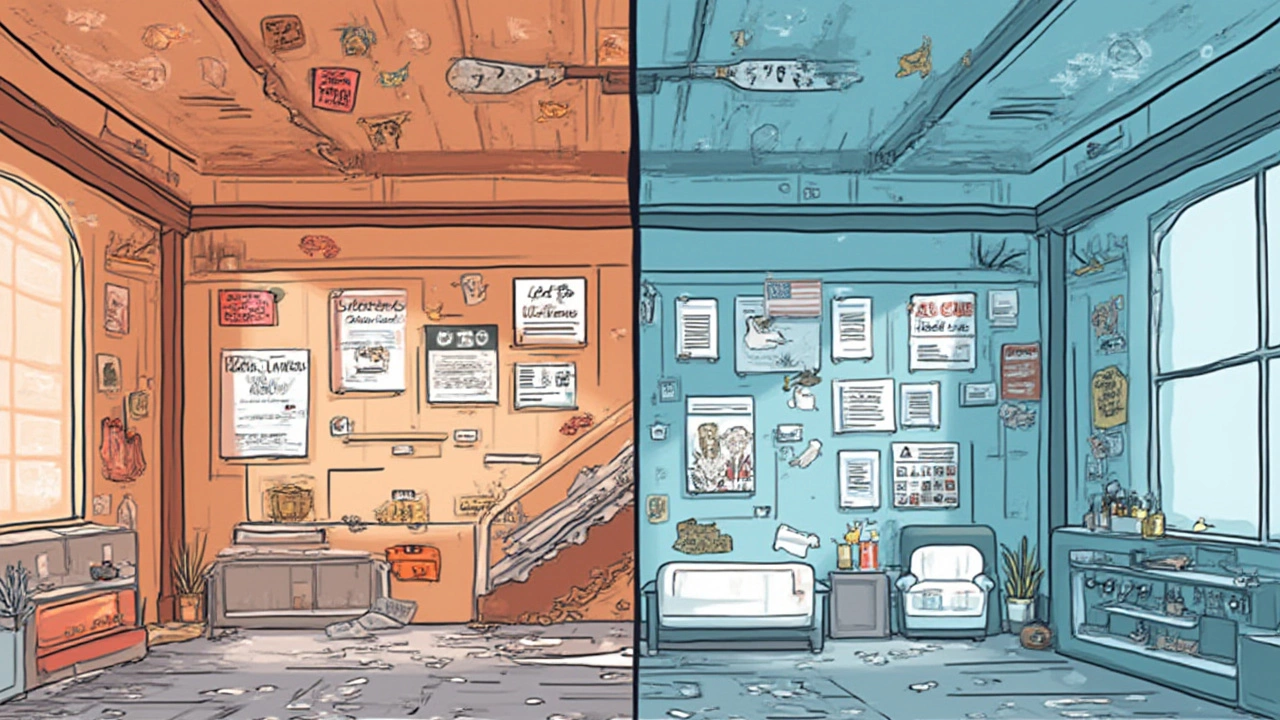Think of all the big, empty warehouses scattered across U.S. cities—soaring ceilings, brick walls, endless square feet just begging to be turned into something cool. It’s tempting, right? Ideas like urban lofts and creative studios spring to mind. But can you actually live in a warehouse in the USA? It’s one of those questions that spark daydreams and legal headaches at the same time. The answer isn’t as simple as a yes or no—it twists around zoning laws, local codes, and a big dose of American ingenuity. If you’re eyeing that neglected warehouse down the block and dreaming of a unique home, buckle up. This isn’t just about grabbing a sleeping bag and moving in. Let’s get deep into the details of turning a warehouse into a cozy—or wild—living space.
Why People Want to Live in Warehouses
You might wonder, "Why would anyone want to live in a warehouse?" The answer mostly comes down to freedom. Warehouses can stretch twice or three times the footprint of a regular city apartment, often for a fraction of the price. No walls, no rules (well, except the legal ones), and the chance to create something truly one-of-a-kind. Picture it: a skateboard ramp across your living room, hangar-sized art studios, or an indoor garden that finally gets enough light. In places like Brooklyn, Detroit, and Downtown LA, old warehouses have already been flipped into stunning urban lofts. People hungry for space, privacy, and a blank canvas are hooked on the idea.
The appeal goes beyond space. Warehouses often have these original industrial details you just can’t fake—massive windows, exposed beams, brick or concrete walls, and loading dock doors. Take a scroll through home-renovation Instagram, and you’ll see hundreds of these spaces turned into jaw-dropping homes with open kitchens, quirky bedrooms, and even climbing walls. The craving for loft living isn’t just an internet trend. Recent real estate studies show a 30% increase in Google searches for "warehouse conversion homes" and "warehouse lofts for sale" between 2022 and 2025.
Whether it's the sweeping size for your favorite hobby or the rugged architecture, it’s easy to see the draw. Artists, designers, musicians, and even young families see warehouses as affordable alternatives to cramped apartments. During the remote work boom after 2020, tons of people started looking for unconventional spaces to live and work. Warehouses popped up in conversations everywhere—from city forums to Reddit threads full of advice, warnings, and wild renovation stories.
Of course, the dream bumps up fast against reality. Even if the price and space are right, you can’t just plop down a futon and call it home. But for plenty of people, the excitement of carving out a life in a warehouse often outweighs the hassle.
Legal and Zoning Hurdles: Can You Actually Do It?
Here’s where the daydreaming about live in a warehouse USA gets tricky. Warehouses are almost always zoned as industrial or commercial space, not residential. Zoning laws restrict what you can do with a property. If it’s not zoned for people to actually live in, you can’t just move in and sleep there legally. Cities and counties write these codes to keep sleeping people away from noisy factories—or to make sure schools and shops aren't next to something dangerous. Sometimes, you’ll even find warehouses that the law doesn’t want turned into living spaces because of fire risk or a total lack of windows and exits.
If you’re caught living illegally in a non-residential warehouse, you’re risking eviction, fines, or the city shutting off your utilities. In extreme cases, you could end up in legal trouble that costs a fortune to sort out. Most U.S. cities—including New York, San Francisco, and Chicago—have cracked down on illegal warehouse living since the 2016 Ghost Ship fire in Oakland that killed 36 people. Building inspectors, fire marshals, and even neighbors get involved if they spot someone living in a place that's just not supposed to be a home.
That’s not to say warehouse living can’t be done—it just takes more work. You need to go through a process called “rezoning” or get a “variance.” This means asking the city for permission to legally convert your warehouse into a residence. It’s not cheap or quick. Sometimes cities welcome these conversions (especially if they want to spruce up a neighborhood), but sometimes they drag their feet. Even if you get the green light, you’ll be expected to bring the building up to code—think fire alarms, emergency exits, real plumbing, and sometimes even a certain amount of sunlight per square foot. The bureaucratic steps look a bit like this:
- Apply for rezoning or a residential variance through your local zoning office.
- Get a building inspection—this usually finds lots of issues to fix, especially in old warehouses.
- Hire an architect or engineer to design your new home layout that follows residential codes.
- Submit blueprints and renovation plans to the city for approval.
- Fix all electrical, plumbing, HVAC, and safety problems. Sometimes, cities will demand energy upgrades too!
- Expect several more inspections before they’ll issue you a certificate of occupancy.
All this paperwork and construction can eat up months (or over a year), and cost well into the six figures if you want to get all the permissions right. Still, for some, the payoff of living in a totally unique, legal warehouse space is worth every hoop they have to jump through.
Check out the way cities handle these conversions in the table below (2024 data):
| City | Rezoning Cost | Average Permit Timeline | Notable Rules |
|---|---|---|---|
| New York | $25,000+ | 6–18 months | Stringent fire codes, natural light |
| Los Angeles | $20,000+ | 4–12 months | Earthquake retrofits often required |
| Chicago | $18,000+ | 4–10 months | Historic preservation limits for many warehouses |
| Houston | $15,000+ | 2–8 months | No citywide residential requirement, more flexible |
By the way, some cities have “live/work” permits for artists or small business owners, where you’re allowed to live in commercial or industrial spaces—but you’ll need proof that you’re actually making a living with your art or trade in the warehouse. Always research local building and zoning codes before you jump in. Calling the city’s building department for a consultation is smarter (and safer) than winging it.

Converting a Warehouse: What It Takes
Turning a concrete cave into something you could actually call home takes way more than a good paint job. First off, you’ve got to figure out utilities. Most warehouses don’t have real bathrooms, kitchens, or even enough plumbing to handle showering every day. Same goes for electric. Maybe it’s wired for forklifts and industrial lighting, not for a stove, fridge, smart devices, or air conditioning. HVAC can be a nightmare—warehouses often have no insulation, so winter means freezing temps and summer feels like a sauna unless you add proper heating and cooling.
Water and sewage can be the biggest headaches. Sometimes, the existing pipes are just too old or too small for daily household use, so retrofitting plumbing for regular living can cost tens of thousands—and require digging up floors. On the electric front, upgrading an industrial system so it’s safe for home appliances often involves running whole new lines and panels. Then there’s the practical side: you’ll need to add interior walls for privacy, soundproofing for peace, and maybe even mezzanine levels if you want bedrooms off the ground floor. Architects love open-concept spaces, but even the most die-hard minimalists want somewhere to hide their socks.
Ask anyone who’s done a warehouse conversion, and they’ll talk about hidden costs. Asbestos in old insulation? Lead in the paint? Riverside warehouses where flooding is a risk? These issues can get expensive fast. It’s smart to get a full structural and environmental check before you buy. Warehouses can also be full of surprises like mold, pests, or weird odors from whatever used to be stored there.
Of course, those who make it happen end up with spaces that look like nothing else. Take the 20,000-square-foot bakery in Kansas City someone turned into a split-level home—gym, workshop, library, you name it. Or the legendary artist lofts in Brooklyn, where entire floors were transformed into shared studios with collapsible walls and communal kitchens. Homeowners often go all-in on cool features: rooftop patios, hidden rooms, oversized showers, or in one case, a climbing wall that doubles as storage. It all comes down to budget, taste, and how much work you’re willing to take on.
Planning and building a warehouse home isn’t a weekend DIY. You’ll need pros: architects, engineers, contractors who know the local codes, even consultants to deal with city permits. It helps to join online forums or connect with people who’ve done it before—they can tell you where to find reclaimed windows, how to deal with heating, and whether to splurge on triple-pane glass. And don’t forget fire safety: smoke alarms, sprinklers, and emergency exits are more than boxes to check—they could save your life.
Risks and Realities: What Can Go Wrong
Warehouse living looks glamorous on TikTok and YouTube, but the risks are real. Number one is safety. Industrial buildings weren’t made for overnight stays, and things like electrical wiring or old heating systems can turn dangerous fast if not updated. Fires in warehouse homes, while rare, are almost always tragic. That’s not just talk—the Oakland Ghost Ship fire cast a long shadow over warehouse living across the country. Many cities increased enforcement after that, shutting down illegal living spaces and introducing strict new building codes.
Insurance is another headache. Most companies won’t touch a warehouse home unless the conversion is totally legal and up to residential code. Even then, expect higher premiums, because weird layouts and unique features can mean more risk for your insurer. If a pipe bursts or a fire starts, you want that policy in force. Otherwise, any disaster is 100% on you, financially.
Comfort is another reality check. Warehouses get loud—trains, trucks, and neighborhood noise can blast through thin walls at all hours. Drafts, leaks, and wild swings in temperature happen if you skimp on renovations. And unless you live in a converted district (think Chicago’s West Loop or DTLA’s Arts District), you might be far from parks, grocery stores, or reliable public transit. Friends could admire your creative streak, but nobody likes carrying groceries through an industrial loading dock after dark.
Community can also be hit or miss. Some warehouse neighborhoods attract artists and entrepreneurs, which can lead to fun events, block parties, or even “open studio” nights. But other spots are isolated with few neighbors around, making you a target for break-ins. Cities sometimes hesitate to extend police, fire, or sanitation services to off-the-grid homes on the edge of an industrial area.
Easily overlooked but important: resale value. Not everyone wants a 5,000-square-foot, no-backyard former factory. Banks also raise eyebrows, which can make mortgages or refinancing tricky if the zoning isn’t 100% residential. Sometimes, homeowners live in renovated warehouses for years then struggle to get their money back—especially if the neighborhood doesn’t gentrify as fast as they hoped.
Accessibility and mobility aren’t always great. If you need elevators, ramps, or easy stairs, many warehouses fall short without expensive upgrades. The sheer size may lure you in, but maintenance feels endless—roofs leak, paint peels, and heating big rooms can cost thousands each winter.

Tips for Making Warehouse Living Work
If you’re still sold on living in a warehouse after reading the hurdles, the key is all about smart planning and patience. Here are concrete tips if you want to make it happen:
- Scout neighborhoods first—don’t fall for the first cool building. Look for places already zoned “live/work” or in districts that encourage adaptive reuse.
- Start with a thorough inspection. Hire a structural engineer and environmental consultant to avoid hidden nasties like asbestos or unstable roofs.
- Get familiar with your city’s zoning codes. Some places are way more flexible than others. Houston, for example, is known for looser rules.
- Factor in all the costs up front. That includes rezoning, permits, plumbing, HVAC, electrical, and those surprise fixes that will pop up.
- Plan your layout for liveability, not just style. Private spaces, proper insulation, real bathrooms, and natural light matter more than exposed brick after the first winter.
- Always prioritize safety—think sprinklers, alarms, and emergency exits. Cities won’t budge here, and neither should you.
- Check insurance options before you buy so you aren’t left in the lurch.
- Do the math on heating and cooling. Warehouses bleed energy. Plan for high-efficiency units or creative solutions like radiant floors or smart skylights.
- Connect with neighbors and local businesses. Community makes even lonelier warehouse zones feel like home.
- Be flexible about timeline—these renovations almost always take longer than you think.
The best warehouse conversions happen when owners respect the building, the law, and their neighbors—and have a solid plan for turning raw square footage into a comfortable home. The freedom and adventure of warehouse living is real, but it comes with a mountain of responsibilities.
So, can you live in a warehouse in the USA? For the bold and persistent, yes—but only if you’re willing to work with a web of zoning laws, construction headaches, and the quirks of converting industrial dinosaurs into modern homes. If you pull it off, you won’t just have a place to live. You’ll have a story worth telling every time someone steps through your loading dock door.


